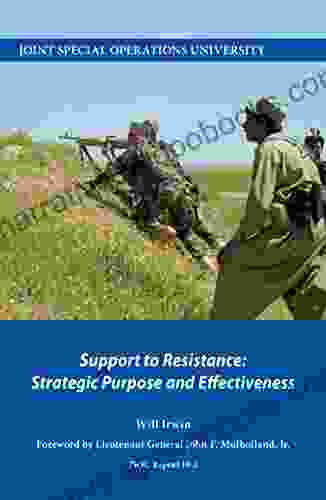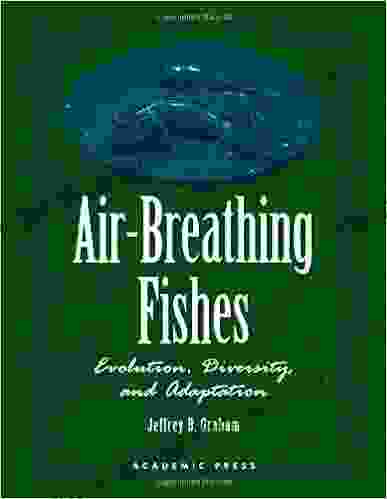Air Breathing Fishes: Evolution, Diversity, and Adaptation

In the vast expanse of Earth's aquatic ecosystems, there exists a group of fishes that defy the conventional boundaries of water-bound existence. These extraordinary creatures, known as air breathing fishes, possess the remarkable ability to supplement their oxygen intake through atmospheric air, a trait that has propelled them to inhabit diverse environments, from the depths of rivers to the shores of estuaries and even the surfaces of terrestrial habitats.
5 out of 5
| Language | : | English |
| File size | : | 8819 KB |
| Text-to-Speech | : | Enabled |
| Screen Reader | : | Supported |
| Print length | : | 299 pages |
Evolutionary Journey
The evolutionary pathway that led to air breathing fishes is a tale of adaptation, innovation, and ecological opportunity. Fossil records suggest that the earliest air breathing fishes emerged approximately 380 million years ago, during the Devonian period. These primitive creatures, known as elpistostegalians, exhibited rudimentary lungs derived from modified swim bladders, allowing them to breathe air when their aquatic environments became oxygen-poor.
Over time, these ancestral air breathing fishes diversified into numerous lineages, each adapting to specific niches and habitats. The mudskippers, for example, evolved amphibious lifestyles, capable of traversing land and utilizing their specialized respiratory mechanisms to survive in air. Lungfishes, on the other hand, developed highly efficient lungs and can withstand prolonged periods of desiccation, enabling them to survive in ephemeral water bodies or burrow into mud during droughts.
Diversity of Air Breathing Fishes
The world of air breathing fishes encompasses a remarkable diversity of species, each characterized by unique adaptations and ecological roles.
Mudskippers (family Gobiidae): These amphibious fishes are highly adapted to life on land, possessing pectoral fins that function as legs and specialized gills that can absorb oxygen from the air. They inhabit intertidal zones and brackish waters, where they forage on small organisms and evade predators by leaping or scuttling across the mud.
Lungfishes (Free Download Dipnoi): Lungfishes are ancient air breathing fishes that possess well-developed lungs in addition to gills. They can survive in both permanent and temporary aquatic habitats and are capable of aestivating in mud cocoons during periods of drought. Some lungfish species, such as the African lungfish, can even estivate for years, waiting for the return of favorable conditions.
Electric eels (family Gymnotidae): While not technically classified as air breathing fishes, electric eels are unique in their ability to breathe atmospheric air through a specialized respiratory organ known as a spiracle. They inhabit South American rivers and wetlands, where they generate powerful electric discharges for defense and communication.
Walking catfish (family Clariidae): Walking catfish are another group of air breathing fishes that have adapted to terrestrial locomotion. They possess accessory breathing organs, such as suprabranchial chambers or labyrinths, that allow them to extract oxygen from the air. These fishes are found in swamps and shallow waters, where they may travel short distances over land to reach new feeding grounds.
Respiratory Adaptations
Air breathing fishes have evolved a variety of respiratory adaptations that enable them to utilize atmospheric oxygen while maintaining their aquatic lifestyles.
Lungs: Lungs are highly vascularized organs that facilitate the exchange of oxygen and carbon dioxide between the air and the bloodstream. Lungfishes possess well-developed lungs, similar to those found in terrestrial vertebrates, while some other air breathing fishes have more rudimentary lungs derived from modified swim bladders.
Suprabranchial chambers: Suprabranchial chambers are specialized structures located above the gills that are lined with highly vascularized tissue. These chambers allow air breathing fishes to extract oxygen from the air while their gills continue to extract oxygen from water.
Labyrinths: Labyrinths are complex structures located in the head that are lined with vascularized tissue. Air breathing fishes with labyrinths can breathe atmospheric oxygen by directing it into these structures.
Cutaneous respiration: Some air breathing fishes, such as mudskippers, also utilize their skin for respiration. Their skin is highly vascularized, allowing them to absorb oxygen from the air through diffusion.
Behavioral Adaptations
In addition to their respiratory adaptations, air breathing fishes have also evolved a range of behavioral adaptations that facilitate their unique lifestyles.
Emergence from water: Air breathing fishes have developed various mechanisms to emerge from the water and access atmospheric air. Mudskippers, for example, can leap out of the water and onto land, while lungfishes can surface and gulp air at the water's surface.
Burrowing: Some air breathing fishes, such as lungfishes, have evolved the ability to burrow into mud or other substrates during periods of drought or unfavorable conditions. They construct burrows that allow them to access air while remaining protected from predators and desiccation.
Estivation: Aestivation is a state of dormancy that some air breathing fishes undergo during periods of drought or environmental stress. They estivate in mud cocoons or other protective structures, reducing their metabolic rate and water loss.
Ecological Significance
Air breathing fishes play significant ecological roles in the ecosystems they inhabit.
Food sources: Air breathing fishes are important food sources for a variety of predators, including birds, reptiles, and larger fish species. They occupy various trophic levels, from primary consumers to top predators.
Nutrient cycling: Air breathing fishes contribute to nutrient cycling by consuming organic matter and excreting waste products that are utilized by other organisms in the ecosystem.
Ecosystem engineers: Some air breathing fishes, such as mudskippers, can modify their habitats by creating burrows and altering the physical structure of intertidal zones.
Conservation Challenges
Air breathing fishes face a range of conservation challenges, including habitat loss, pollution, and overexploitation.
Habitat loss: The destruction or degradation of intertidal zones, wetlands, and other aquatic habitats threatens air breathing fishes that rely on these ecosystems for survival.
Pollution: Pollution from industrial effluents, agricultural runoff, and plastic waste can have detrimental effects on air breathing fishes, impairing their respiratory function and overall health.
Overexploitation: Some air breathing fishes, such as lungfishes, are heavily exploited for food or traditional medicine, leading to population declines and potential endangerment.
Air breathing fishes are a testament to the remarkable diversity and adaptability of life on Earth. Their ability to breathe atmospheric air has enabled them to colonize a wide range of habitats, from the depths of rivers to the surfaces of terrestrial environments. Their evolutionary journey and ecological significance make them subjects of ongoing research and conservation efforts, ensuring the preservation of these fascinating creatures for generations to come.
5 out of 5
| Language | : | English |
| File size | : | 8819 KB |
| Text-to-Speech | : | Enabled |
| Screen Reader | : | Supported |
| Print length | : | 299 pages |
Do you want to contribute by writing guest posts on this blog?
Please contact us and send us a resume of previous articles that you have written.
 Book
Book Novel
Novel Page
Page Chapter
Chapter Text
Text Story
Story Genre
Genre Reader
Reader Library
Library Paperback
Paperback E-book
E-book Magazine
Magazine Newspaper
Newspaper Paragraph
Paragraph Sentence
Sentence Bookmark
Bookmark Shelf
Shelf Glossary
Glossary Bibliography
Bibliography Foreword
Foreword Preface
Preface Synopsis
Synopsis Annotation
Annotation Footnote
Footnote Manuscript
Manuscript Scroll
Scroll Codex
Codex Tome
Tome Bestseller
Bestseller Classics
Classics Library card
Library card Narrative
Narrative Biography
Biography Autobiography
Autobiography Memoir
Memoir Reference
Reference Encyclopedia
Encyclopedia Laurent Gounelle
Laurent Gounelle Allyson P Brantley
Allyson P Brantley Katy Perry
Katy Perry Alix Lee
Alix Lee Michaela J Compton
Michaela J Compton Helen J Williams
Helen J Williams Sina Queyras
Sina Queyras Julio Ramos
Julio Ramos Kirsty Duncanson
Kirsty Duncanson Mona Liza Santos
Mona Liza Santos Paige Tyler
Paige Tyler Renita Burgess
Renita Burgess Randall L Schweller
Randall L Schweller R Barri Flowers
R Barri Flowers Allan F Bower
Allan F Bower Ed Temple
Ed Temple Marian Powys
Marian Powys Jeff Greenfield
Jeff Greenfield Pauline Fairclough
Pauline Fairclough Alyson Belle
Alyson Belle
Light bulbAdvertise smarter! Our strategic ad space ensures maximum exposure. Reserve your spot today!

 Vic ParkerUnlocking the Power of Resistance: A Comprehensive Guide to Strategic Purpose...
Vic ParkerUnlocking the Power of Resistance: A Comprehensive Guide to Strategic Purpose...
 Lawrence BellDiscover the Heart of the Finger Lakes: A Memoir Anthology that Captures the...
Lawrence BellDiscover the Heart of the Finger Lakes: A Memoir Anthology that Captures the...
 Ryūnosuke AkutagawaUnveiling the Power of Environmental Chemistry for a Sustainable World: An...
Ryūnosuke AkutagawaUnveiling the Power of Environmental Chemistry for a Sustainable World: An... Jackson HayesFollow ·14.6k
Jackson HayesFollow ·14.6k Stuart BlairFollow ·15.6k
Stuart BlairFollow ·15.6k Fletcher MitchellFollow ·16.2k
Fletcher MitchellFollow ·16.2k Gary ReedFollow ·4.3k
Gary ReedFollow ·4.3k Matthew WardFollow ·11.4k
Matthew WardFollow ·11.4k Calvin FisherFollow ·3.1k
Calvin FisherFollow ·3.1k Milton BellFollow ·13.5k
Milton BellFollow ·13.5k VoltaireFollow ·10.8k
VoltaireFollow ·10.8k

 F. Scott Fitzgerald
F. Scott FitzgeraldUnravel the Enigmatic Murder of Mary Russell: A...
Prologue: A Grisly Discovery In the...

 Connor Mitchell
Connor MitchellLittle Quilts: Gifts from Jelly Roll Scraps
Embrace the Art...

 Harold Powell
Harold PowellPoverty Survival Hope In An American City: A Pulitzer...
A testament to the resilience of the human...

 Ray Blair
Ray BlairConfronting Global Warming: Population, Resources, and...
Global warming is one of the most pressing...

 Gary Cox
Gary CoxStyle Your Most Authentic Self and Cultivate a Mindful...
Unlock Your True...

 Caleb Long
Caleb LongEmbark on a Colorful Patchwork Adventure: Discover 20 To...
Step into the captivating world of...
5 out of 5
| Language | : | English |
| File size | : | 8819 KB |
| Text-to-Speech | : | Enabled |
| Screen Reader | : | Supported |
| Print length | : | 299 pages |






